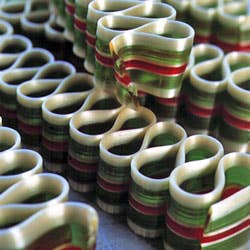
Candy Kitchen
Holiday dreams of old-fashioned sweets come true at Hammond’s, just south of the North Pole in Denver.
It's modern-day wizardry, the business of spinning sugar and water into glistening, wondrous candies that recall sweet childhood fantasies. The fragile, crimped spirals of red-and-green ribbon candy, tempting beyond measure, belong in a Victorian tableau full of ladies in high-collared coats with their beaux in splendid, snow-covered carriages. Perfectly formed peppermint pillows, each with 16 tiny stripes, evoke Christmases past. And the dainty art candies, with miniature designs worked into their centers, are simply astonishing.
It is edible art, mysteriously emerging from a dimly lit assemblage of enormous copper bowls, heavy steel tables, and vintage iron machines. The back rooms of Hammond Candy Company in Denver resemble nothing so much as a foundry. The massive New York Batch Roller, circa 1930, glows from the warmth of its gas-fired flames as it keeps a skein of pulled candy warm and pliable. The air is heavy with the intoxicating scent of bubbling sugar. Pipes gurgle. Steam rises.
But the honey-colored mixture simmering in the well-used bowls is nothing more than sugar, corn syrup, and water. The alchemy that turns it to gold (and red and green) lies in knowing when to pour it out on the steel slab and how to fold, knead, pull, color, and flavor it. The professional "candy man" needs both physical strength and the delicate hand of an artist. When he expertly snips through the molten mass of sweetness with an enormous pair of shears, he's like a glassmaker at work.
Examples of such artistry were once common in small confectioners' shops across America. But Hammond's, founded in 1920, is one of the last of the breed. The kitchen turns out several hundred different sweets a year—not only hard candies but also a scrumptious array of chocolates, brittles, toffees, and caramels.
It all started with Carl T. Hammond—who went to work at the turn of the century as a "hard-candy man" just after finishing the eighth grade. Carl could spin warm canes so quickly, it is said, that two "crookers" were required to keep up with him. His son, Tom, was equally skilled, and loved candy making so much that he never considered retiring. At the age of 62, he had a fatal heart attack at home on his lunch break.
The beauty of Hammond's candy is obvious, but the time and care involved may not be. Consider the making of art candy. First an intricate design is drawn on paper, such as a rose and stem, checkerboard, snowflakes, or orange, lime, and lemon fruit slices. Once the desired design is chosen, the heated syrup must be kneaded, colored, and shaped. Then the brilliant mass is arranged so that the image runs down through its center. Carefully, without squashing the design, the soft candy rope is pulled, its diameter contracting. Just as it begins to harden, the rope is sliced into half-inch pieces, its design intact and crisply delineated at top and bottom.
Candy canes are nearly as time-consuming. Hammond's canes have two layers: the center, to which the flavor is added, and the jacket. Both start as sugar syrup heated to 330°, then turned out onto a slab. The centers are pulled by machine to add air, giving the candy its lightness. The jacket is colored, and pulled by hand just long enough to give it a high gloss. Next, the jacket is wrapped around the flavored center, after which the canes are pulled and cut. Finally, they are rolled, hand-crooked and delicately arranged on trays. They cool to shiny perfection. Their flavor is bracing peppermint, with an airy texture that explodes in your mouth. These are a far cry from machine-made canes, heated typically to 280°, which ensures that they remain unappealingly sticky.
Hammond's customers certainly are appreciative—even if they don't always recognize the artistry at work. After all, who can resist the charm of these festive, jewel-like confections? Eating them honors a family's devotion to tradition and sweeps us back to the spun-sugar dreams of our youth.
Keep Reading
Continue to Next Story










